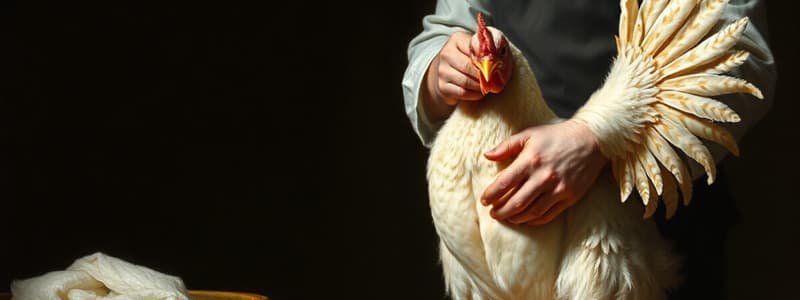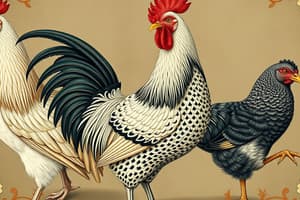Podcast
Questions and Answers
What is the classification of chickens that are younger than 10 weeks old?
What is the classification of chickens that are younger than 10 weeks old?
- Toms
- Broilers (correct)
- Hens
- Fryers (correct)
Which type of poultry is described as being ready to be cooked?
Which type of poultry is described as being ready to be cooked?
- Frozen
- Sliced (correct)
- Dressed (correct)
- Dehydrated
Which statement about thawing frozen poultry is accurate?
Which statement about thawing frozen poultry is accurate?
- The refrigerator is the safest place to thaw. (correct)
- The microwave is the best method for thawing.
- Thawing should be done under warm water.
- It can be defrosted at room temperature.
What color should the juices from a well-done chicken or turkey indicate?
What color should the juices from a well-done chicken or turkey indicate?
How long can fresh, ready-to-cook poultry safely be kept in the refrigerator?
How long can fresh, ready-to-cook poultry safely be kept in the refrigerator?
Which of the following styles of poultry indicates that it has not yet been processed?
Which of the following styles of poultry indicates that it has not yet been processed?
What is the recommended method for storing frozen poultry?
What is the recommended method for storing frozen poultry?
Which characteristic might differ between white meat and dark meat in poultry?
Which characteristic might differ between white meat and dark meat in poultry?
What is the appropriate action to take if poultry has been defrosted but not cooked?
What is the appropriate action to take if poultry has been defrosted but not cooked?
Which of the following best describes mollusks?
Which of the following best describes mollusks?
How long can fish typically be stored in a freezer?
How long can fish typically be stored in a freezer?
What is a sign of aging in fish after death?
What is a sign of aging in fish after death?
What method indicates that a live mollusk is still alive?
What method indicates that a live mollusk is still alive?
What is the recommended way to purchase shellfish?
What is the recommended way to purchase shellfish?
What happens to the eyes of fish after they die?
What happens to the eyes of fish after they die?
What process may fish processors participate in for quality control?
What process may fish processors participate in for quality control?
Study Notes
Poultry Classification
- Ready-to-eat poultry classification varies by species, considering age and gender.
- Chickens: Broilers and fryers, both younger than 10 weeks old.
- Turkeys: Toms and Hens.
Poultry Composition
- The composition of poultry is similar to meat, consisting of muscle tissue and connective tissue.
- Both turkeys and chickens possess both white and dark meat.
Poultry Types and Styles
- Type:
- Fresh
- Frozen
- Cooked
- Sliced
- Canned
- Dehydrated
- Style:
- Live
- Dressed
- Ready-to-cook
- Convenience categories
Preparing Poultry
- All ready-to-cook poultry should be washed inside and out, then patted dry with paper towels.
- Thawing frozen poultry is best done in the refrigerator, requiring planning ahead.
Checking Poultry Doneness
- Oven-roasted poultry turns golden brown.
- Juices should run clear.
- Firm flesh when pressed with fingers, with white meat potentially firmer than dark meat.
- Wiggle the drumstick.
Storing Poultry
- Refrigerated: Fresh, ready-to-cook poultry can be safely kept in the refrigerator at 40°F (4°C) or below for up to three days.
- Store in the bottom portion of the refrigerator to prevent drippings contaminating other foods.
- Frozen: Whole frozen poultry can be stored from six to twelve months at (-18°C).
- Never thaw and refreeze breaded or fried poultry, or any other meat unless it has been cooked.
Fish and Shellfish Types
- Vertebrate:
- Finfish: Possess fins and internal skeletons.
- Invertebrate:
- Shellfish: Includes crustaceans and mollusks.
- Crustacean: Segmented body with an exoskeleton of a hard upper shell and soft under shell.
- Mollusk: Soft, unsegmented body usually enclosed in a shell.
- Shellfish: Includes crustaceans and mollusks.
Purchasing Fish and Shellfish
- Fish processors may submit to voluntary inspection and grading.
- Fish can be purchased fresh or frozen, in various forms like whole, drawn, dressed, steaks, fillets, and sticks.
Signs of Decay in Fish
- Eyes: Flatten and become concave, pupil turns gray/brown, cornea becomes opaque and discolored.
- Gills: Bright red gills turn a paler brown.
- Gaping: Sign of aging, or may be due to rough handling.
Purchasing Shellfish
- Live Shellfish: Lobsters, crabs, oysters, and clams can be purchased alive in their shells.
- Shellfish are highly perishable.
- Processed Shellfish: Shellfish can also be bought cooked in the shell and chilled or frozen.
- Oysters can be bought live in the shell, or shucked, then chilled, frozen, or canned.
- Tapping on the shell of live mollusks should cause it to close more tightly.
Storing Fish and Shellfish
- Frozen: Freezing extends fish keeping time, storing up to nine months depending on the type.
Studying That Suits You
Use AI to generate personalized quizzes and flashcards to suit your learning preferences.
Related Documents
Description
This quiz covers the classification of poultry, including types, styles, and composition. It also focuses on the correct preparation methods and checking doneness for ready-to-cook poultry. Test your knowledge on poultry specifics!




